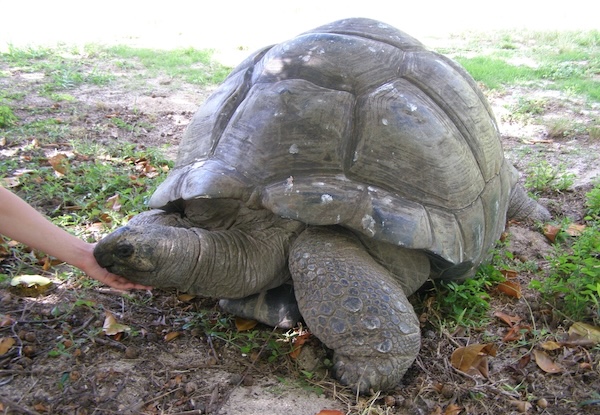Aldabra Tortoise
These reptiles are the second largest tortoises in the world, with the biggest recorded at over 670 pounds (304 kilograms).
Day of Creation: six
Biblical Kind: tortoise (includes all tortoise species)
Status: vulnerable
Length: females average 3 feet (0.9 meters); males average 4 feet (1.2 meters)
Weight: females average 300–350 pounds (45–113 kilograms); males average 550–600 pounds (250–272 kilograms)
Habitat: grasslands, scrubs, swamps, and dunes of the Seychelles
Lifespan: 100–200 years
Diet: grasses, leaves, woody stems, fruits, small animals, carrion
Family Life: may live alone or in groups
Reproduction: 9–25 eggs hatch after eight-month incubations
Fun Facts
The shells of both turtles and tortoises are attached to their bodies by their vertebrae and ribcages. That means they can feel through their shells. Although they both have shells, tortoises are not related to any of the multiple turtle kinds. Tortoises are land-dwelling animals and have heavy domed shells and thick, stumpy feet. Turtles dwell in or around the water and have flat, streamlined shells and webbed feet or flippers. Although box turtles behave like tortoises, they belong to the pond turtle kind.
Aldabra (al-DAH-brah) tortoises are believed to be the longest-living land animals alive today. The oldest land animal that is alive today that scientists are aware of is Jonathan the Aldabra tortoise, who hatched no later than 1832. He resides in Saint Helena on the grounds of the Plantation House, the governor’s home. Another Aldabra tortoise named Adwaita was 255 years old when he died at the Kolkata Zoo in India.
Aldabra tortoises play the same role in the Seychelles as elephants do in Africa and Asia. They push down trees and shrubs, clearing paths for smaller animals. They disperse the seeds they eat through their feces. Habitats called “tortoise turf” are shaped by their grazing and are comprised of dwarfed grasses and herbs that grow their seeds close to the ground to avoid the tortoises’ jaws.
To protect themselves from heat and insect bites, Aldabra tortoises wallow in mud or soak in shallow freshwater pools.
Aldabra tortoises are quite social and will rub their noses on the necks and heads of other tortoises in a behavior called “nosing.” They are also friendly toward humans and can learn to identify individual people.
